The most beautiful and complex mammals on our planet, elephants are vastly misunderstood. Unbeknown to most, there are actually three different elephant species.
This in-depth article compares African vs Asian elephants, showing all the key differences and subtleties, as well as the best places to see them in the wild.
Of course African elephants are native to Africa and Asian elephants to Asia. But there is so much more than that. So read on…
Three Species of Elephant to Compare
To compare African vs Asian elephants is simplistic. There are actually three species of elephant and these are the three largest terrestrial mammals on our planet.
The daddy of them all is the African bush elephant (Loxodonta africana). Encounter one in the wild and you’ll appreciate just how big they are.

Most of the elephants you encounter in zoos are Asian elephants (Elephas maximus). There are four different Asian elephant subspecies – Indian elephant, Malayan elephant, Sumatran elephant and Sri Lankan elephant.
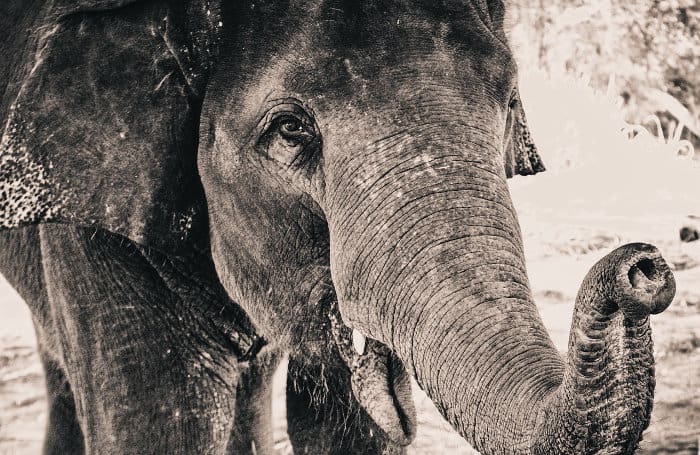
The smallest of the species is the African forest elephant (Loxodonta cyclotis), which separated from its near neighbour the bush elephant some 5 million years ago.
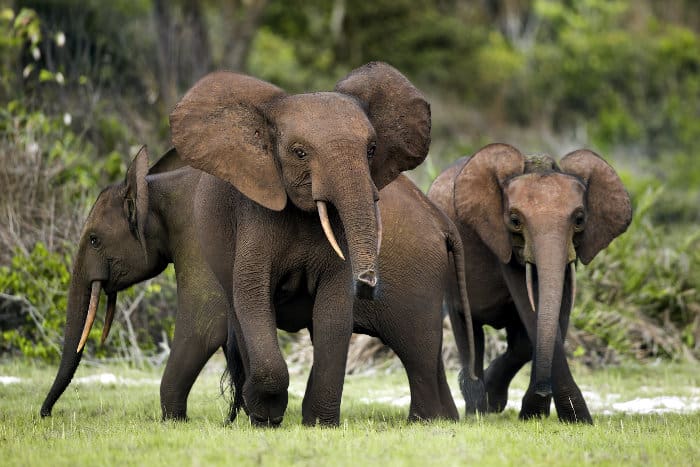
African Elephants vs Asian Elephants – How to Tell Them Apart
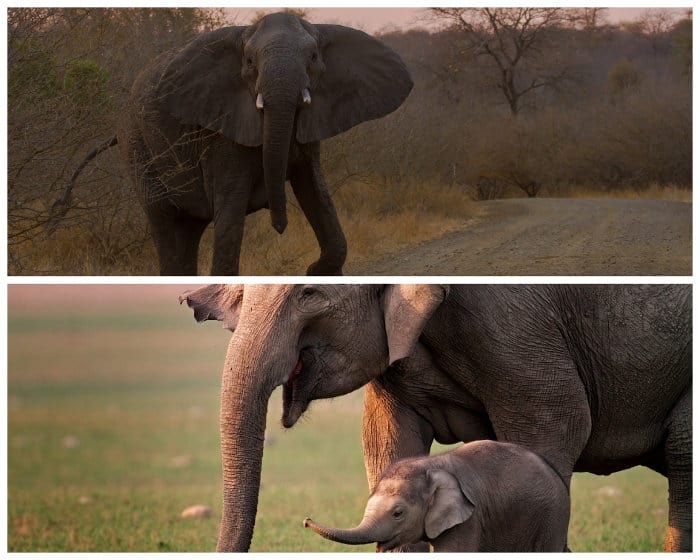
African vs Asian elephants size
African elephants are the biggest mammals currently walking our earth. Mature males stand up to four metres tall at the shoulder and can weigh over six tons.
Mature Asian elephants measure in at 2.75 metres in height and four tons in weight. The females of both species are slightly shorter and lighter. When you stand before an elephant it’s difficult to appreciate three tons from four tons – they just look enormous. 🙂
African forest elephants are considerably smaller. For example, fully grown elephants in the Congo Basin may only weigh one ton.
These are average heights and weights so it’s hard to distinguish the species purely on size. There are far more telling signs.
Ears
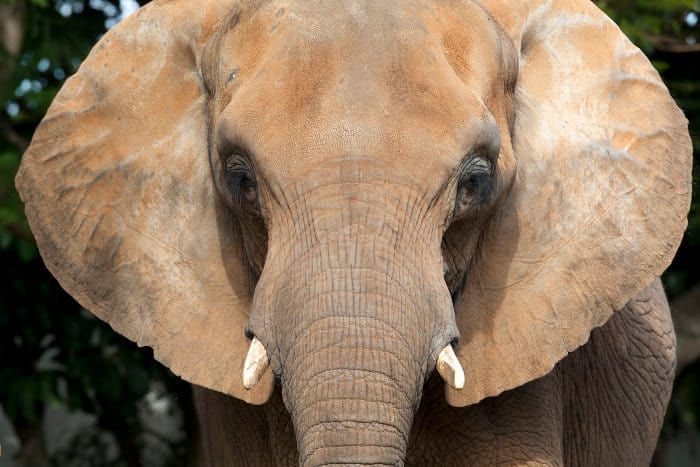
The simple way to differentiate African and Asian elephants is through their ears. Elephants flap their ears to cool themselves down. It’s hotter in Africa so they need much larger ears for this to be effective.
Look at an African elephant’s ear and you’ll see it’s shaped like a map of Africa. Asian elephant ears are significantly smaller and rounder.
Head shape

Both species are big and grey and flap their trunks along the dusty ground. They can be frightening to encounter yet enchanting in so many ways. But look carefully at the different elephants and you’ll see that there are as many differences as similarities.
Asian elephants have a twin-domed head. You’ll notice a rivet running straight up their head, dividing it in two. So remember, twin-domed head with small ears.
In comparison African elephants have rounded heads, very similar to our own.
Tusks
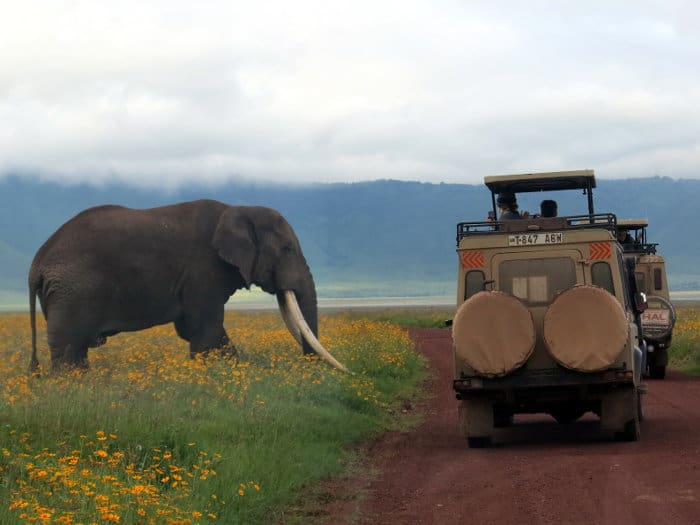
Trunk and tusks, they are the two key characteristics of an elephant right? Erm, no. Female Asian elephants don’t display the beautiful ivory tusks. It’s only the males.
Travel to Africa and all the elephants have tusks, male and female, young and old. Tusks never stop growing and are a great indication of an elephant’s age. Visit Ngorongoro Crater and you’ll see some of the continent’s biggest bulls, with tusks that curl higher than a safari vehicle.
Elephants have tusks at birth but these fall out after a year, just like we lose our baby teeth. Then their adult tusks begin to develop in years two and three.
Tusks are used for digging and finding food but have been the death of many elephants. Poachers come for their ivory, a very sorry tale from across Africa and Asia. When the tusk’s root is damaged then the tusk will never grow back.
Feet
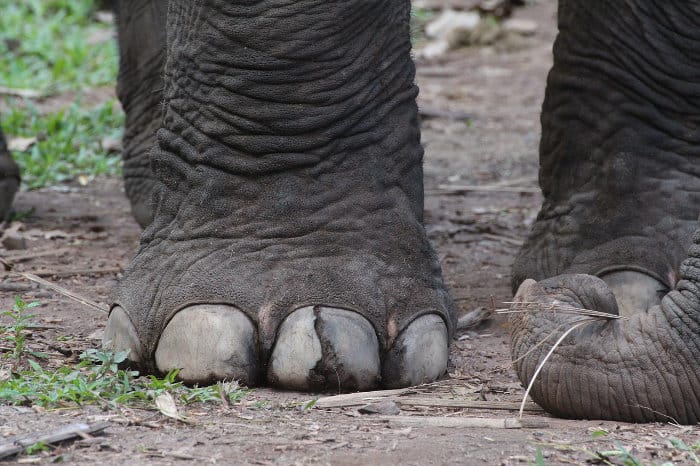
Now it starts getting complicated. Asian elephants have an extra toe, with five on the front feet and four on the back feet (compared with four and three). We wouldn’t recommend getting close enough to count the toes. 🙂
Researchers use feet as the key factor in distinguishing elephants. They are like our fingerprints, with a unique pattern of ridges and fissures. Measuring the size of a footprint is the best way to guess an elephant’s size. They don’t really have toes, just two nails that are buried within the flesh of each foot.
Skin
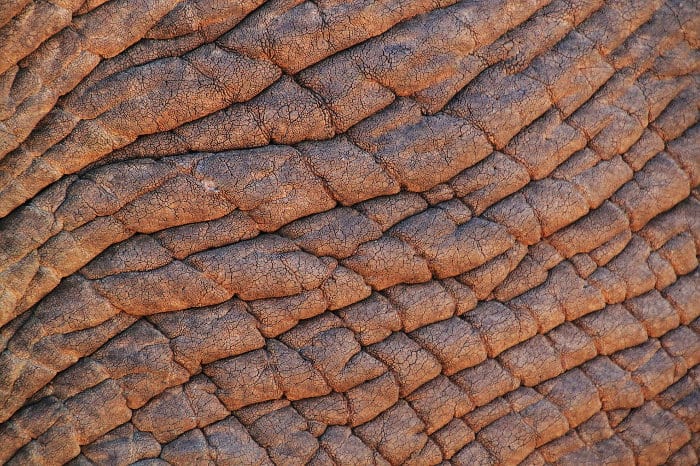
Wrinkles, wrinkles, wrinkles…there certainly isn’t any wrinkle cream that can work for the African elephant. These giants have saggy skin with countless wrinkles.
Maybe the Asian elephants went to a beauty salon at some point. Their skin is tauter, pulled tighter with less wrinkles.
Trunk

One of the great wonders of nature, an elephant trunk has up to 40 000 individual muscles (the entire human body has just 639!). It can do many jobs, from feeding and gripping to painting a picture with a brush (that actually happened 🙂 ).
Look closely and there are two key differences. An African elephant trunk has more rings, just like its skin has more wrinkles. It also has two fingers. These fingers protrude from the top and the bottom of their trunk, allowing the African elephant to pick up and fully manipulate different objects.
Asian elephants have only one finger at the top, so they don’t have the same trunk dexterity. Instead, these smaller elephants will use other parts of their trunk to move food towards their mouths.
Teeth

If you are close enough to look in a wild elephant’s mouth then you are in big trouble. Nobody likes an amateur dentist checking out their molars, especially nobody weighing six tons.
So let’s check out the photos instead. Asian elephants have diamond-shaped teeth while African elephants have sloping teeth, known as loxodont. This is a clue to their scientific Latin name – Loxodonta africana.
Both species get six sets of molars. After one tooth is ground down through constant rubbing a replacement pushes through. After six sets it’s almost over – a lack of working teeth being one of main causes of elephant death.
What sounds do elephants make? Is there a difference between African and Asian elephants?
Elephants make a fabulous variety of sounds, notably rumbling and trumpeting, as well as barks, grunts, snorts and roars. You can listen to all the different sounds made by elephants in this article.
Nobody understands why Asian elephants can make soft chirping and squeaking sounds, but African elephants cannot. Common sense suggests it is something to do with the vocalisations made possible by the larynx, but as we’ve said before, there is so much about elephants we still don’t know.
Key Differences Between African and Asian Elephant Species
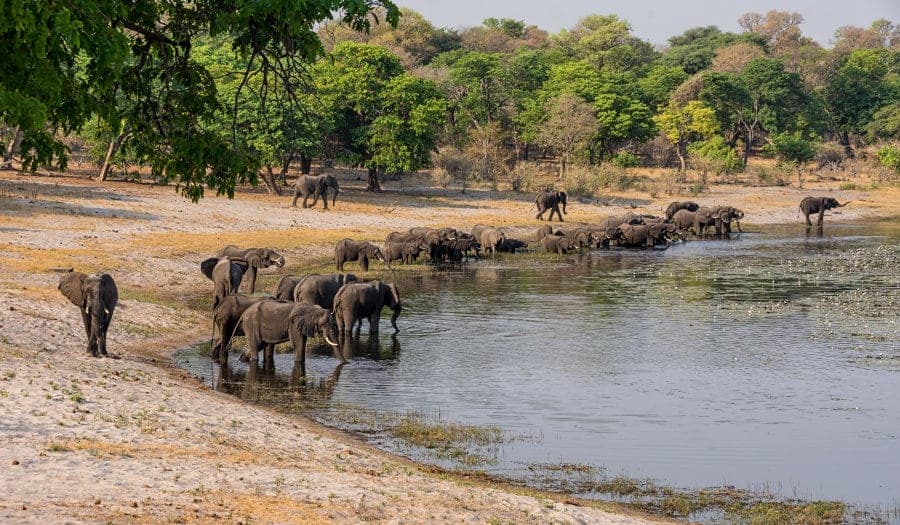
African vs Asian elephant population
African bush elephants once numbered more than 10 million. In the last 60 years their population has dropped to 400 000, mostly due to habitat loss and poaching.
However, the wild population of Asian elephants is only around 50 000, although this number is supplemented by a larger number of captive elephants.
To understand this comparison consider Chobe National Park in the north of Botswana. Researchers believe that there could be up to 100 000 African elephants in and around the park at the height of dry season. That’s more than double the total population of Asian elephants – in just one place!
Before colonization there were more than 2 million African forest elephants. Only around 5% (100 000) of these remain.
Habitat and diet
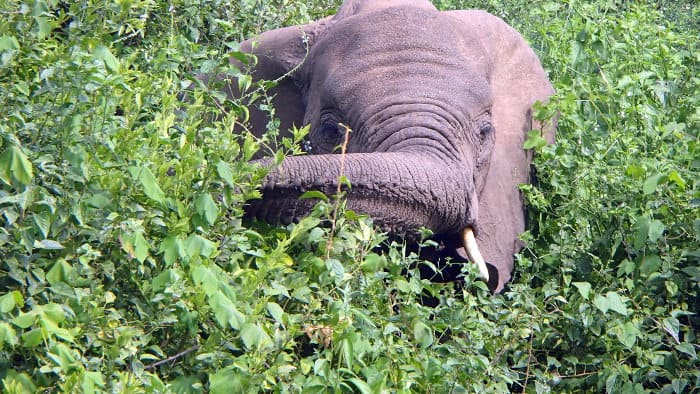
Elephants are herbivores. Using their trunks and tusks they tear at branches, ripping off the foliage. On a busy day an African elephant can go through 450 kg of vegetation.
Some Asian elephants have been recorded feeding on 112 different species of plant in just a few days. This species will “only” eat up to 150 kg per day but they do have a more advanced digestive system, meaning a greater percentage of that food is converted into energy.
Historic range
It’s believed that African elephants once roamed almost the entire African continent, certainly everywhere south of the Sahara. Even as recently as 1930 it was believed there were 10 million elephants wandering across Africa.
Asian elephants were similarly widespread. Their historic range covers most of Asia, from the foothills of the Himalayas all the way south to small Indonesian islands, then north towards Turkey, Iran and the Caucasus.
African forest elephants have always been concentrated around the forests of the Congo Basin. These elephants adapted and evolved for this thick, tangled world, their smaller stature making it easier to travel around such crowded undergrowth.
Current range

Elephants provide one of nature’s saddest stories. It’s harrowing to think that we humans have been responsible for elephants losing 95% of their population in little over a century. Just imagine having to tell your grandchildren that they could never look a wild elephant in the eye, because we have been too greedy and insensitive.
There is little difference in the plight of African and Asian elephants. All three species have seen their range significantly reduced, due to habitat loss and habitat fragmentation.
Asian elephants have a handful of final enclaves, most notably in Sri Lanka, Bangladesh and parts of Southeast Asia.
Forest elephants still roam a lot of the Congo Basin but many migratory routes are now closed. The largest populations are found in Gabon; go gorilla trekking in Uganda or Rwanda and you may also spot some forest elephants in the national parks.
The world’s largest land mammal can no longer roam as freely as before. There is a two-fold problem. Their range is diminishing from the outside, the fringes of their habitat reduced year upon year. For example, African elephants have been virtually wiped out in places like West Africa and Angola.
Human encroachment has disrupted the heart of the range as well. So while elephants can still be considered widespread across Africa, huge chunks of the continent’s heart haven’t seen elephants for years.
Endangered status
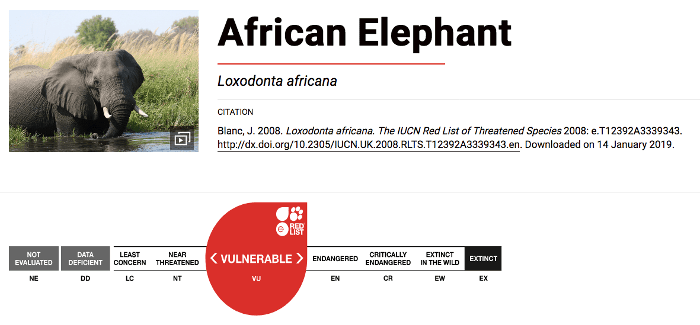
All three of the elephant species are considered vulnerable on the IUCN red list. They are under threat and have become a symbol of endangered wildlife, particularly the impact that humans can have on a species.
There’s more sad news for Asian elephants. Their population continues to decline, in contrast to increasing populations in Africa.
Poaching and hunting are major factors but don’t discount other factors. Elephants can decimate landscapes, clearing great swathes of woodland and bush in just a few days. People don’t seem to like that. So the elephants are hunted, poached, or moved on.
Social structure – African vs Asian elephants
All elephant species have a similar matriarchal structure. An older female leads a herd of sisters, daughters and their calves. After death the matriarch is replaced by her eldest daughter.
Upon reaching maturity, males leave the matriarchal herd to join bachelor groups. These are led by the largest bull and go in search of the elephant cows.
Jostling and fighting is common as bulls seek to assert dominance and get a choice pick of mates when meeting a matriarchal herd.
When a herd grows too big for the available food source then it must split. This is why Asian elephant herds tend to comprise fewer individuals, typically from six to ten.
African elephant herds can number above 20 and sometimes travel together in super-herds, as seen in places where food is abundant.
African and Asian Elephants – Severe Threats Now and in the Future
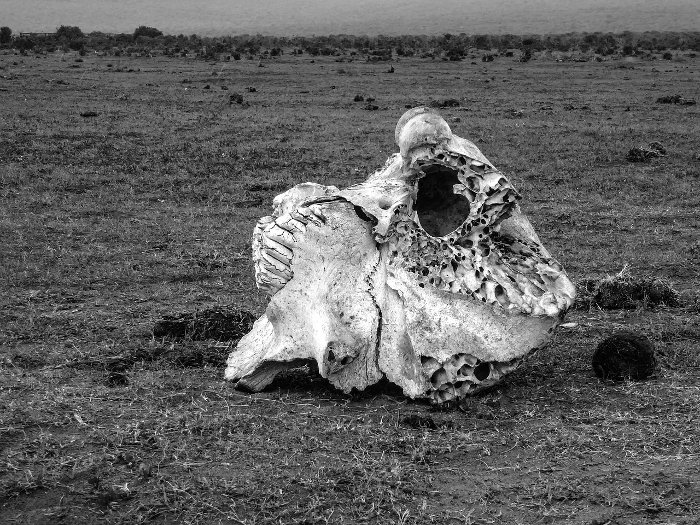
Habitat fragmentation is the main challenge facing both African and Asian elephants today. This is caused when the elephants’ natural habitat is broken into disparate pieces. It’s like a jigsaw puzzle – take away a few sections from the middle and the picture is no longer the same.
Elephants roam and migrate across huge distances, sometimes moving over 2000 kilometres between different feeding grounds and water sources. When their habitat becomes fragmented they are unable to make these journeys.
For example, building a road across a savannah may only seem like a tiny slither of habitat loss. But by cutting the habitat in two it severely restricts where elephants can travel.
This same challenge is facing both Asian elephants and African bush elephants.
African forest elephants suffer a different key challenge – their slow birth rate. It takes this species longer to reproduce, so the population is unable to recover from poaching and hunting.
African vs Asian Elephants – Hope for the Future
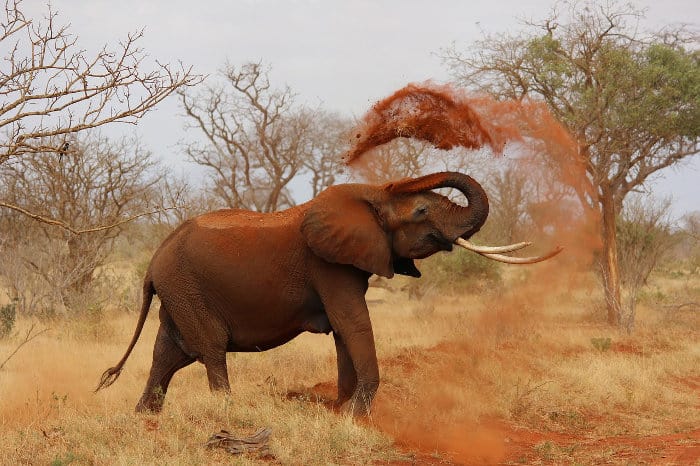
Prince William is among the people who have suggested that elephants and rhinos could become extinct in our lifetime. Poaching for ivory is a perennial threat, even if China finally implemented an ivory trade ban in 2018.
Most countries made buying and selling ivory illegal on January 18th 1990, when the African elephant was listed in CITES (Convention on International Trade in Endangered Species) as a restricted and endangered species.
In 2016 Kenya burned an enormous ivory stockpile worth USD 105 million, a message to poachers that took 5% of the global ivory stock out of circulation.
So there is hope. Organisations and countries are working together and the African elephant population is increasing. Take the Kavango Zambezi Transfrontier Conservation Area as an example. By successfully connecting wildernesses in five different countries there is now over 500,000 square kilometres of protected area for elephants to freely roam.
Over in Asia the situation is more severe. There simply isn’t enough wilderness to accommodate a greater elephant population. Deforestation is increasing and Asian elephants have become isolated in small pockets of the continent.
Can Asian and African Elephants Mate Together?
African father Jumbolino and Asian mother Sheba gave birth to an elephant calf named Motty in 1978, named after George Mottershead (who founded the Chester Zoo in 1931). It was the first time the two species had successfully interbred.
Unfortunately, young Motty only lasted 12 days, despite the best efforts of many vets and elephant specialists. There are no other records of Asian and African elephants conceiving a crossbreed calf.
There is no crossover in range between the two species, so African and Asian elephants will never meet each other in the wild. So we’ll never know about the ears and trunk and teeth of a crossbreed calf.
Records of African bush elephants and African forest elephants crossbreeding also don’t exist. These two species split from each other around 5 million years ago and scientific knowhow would suggest that the two species are unable to effectively mate.
However, as their range does crossover, who is to know whether a big bush elephant bull doesn’t charge into the bush and find himself a forest elephant female.
One of the key definitions of a distinct species is whether they are able to mate and produce fertile offspring. For example, there are many breeds of domestic dog but these all belong to the same species. Asian and African elephants are distinct, as the demise of young Motty proved.
African vs Asian Elephants – Where to See Them in the Wild

Fortunately we are part of a generation that can still come face to face with wild elephants. So let’s celebrate.
The best place to see Asian elephants in the wild is Sri Lanka. Here they are most abundant and also the country’s national symbol.
Some 3000 elephants occupy the jungles of Thailand, particularly Khao Sok, Kui Buri and Khao Yai national parks.
You can also see elephants in India, at Corbett and Nagarhole national parks, as well as a few places in Indonesia and Nepal.
However, the best place to encounter wild elephants is in Africa. Great herds of African elephants continue to roam and there are superb safari destinations to consider.
Botswana has preserved wildlife migration routes and there are more elephants here than anywhere else. They travel freely from neighbouring Namibia, through the Central Kalahari and Okavango Delta, onward to Chobe National Park.
In dry season you can feast your eyes on the sight of over 130 000 elephants in Chobe – so many you quickly stop counting.
Tanzania is another excellent haven. Encounter enormous herds in Tarangire National Park, where they wander amid a landscape of baobab trees. Selous and Ruaha are other options while the old bulls in Ngorongoro Crater are considered Africa’s largest elephants.
Elephants walk beneath the snow-capped cone of Mount Kilimanjaro in Amboseli National Park, the finest pachyderm experience in Kenya.
Then there are elephants to find in Namibia, Zimbabwe and Zambia, as well as in various parks across South Africa.
For forest elephants travel to Gabon, where they are most numerous. Or go mountain gorilla trekking in Uganda and Rwanda, walking on paths created by elephants.
Elephants can still be seen in a handful of West African national parks, notably Mole National Park in Ghana. However, their numbers are low and you won’t see the same large herds as in East or Southern Africa.
African vs Asian Elephants – What Do You Want to See?

We think it’s impossible to have a favourite. All three species showcase the beauty and complexity of nature. And to see them in the wild is one of the great wildlife experiences.
African vs Asian Elephant Joke (Just for Fun)
An animated jeweller called the police station to report a robbery.
“You’ll never believe what happened, sergeant. A truck backed up to my store, the doors opened. Out comes these burglars and they lead an elephant out of the truck. The elephant then breaks through my plate glass window, sticks his trunk in, sucks up all the jewelry. Then they lead the elephant back into the truck. The robbers close the truck doors and the truck pulled away.”
The desk sergeant said, “Could you tell me, for identification purposes, whether it was an Indian elephant or an African elephant?”
“What’s the difference?” asked the jeweller.
“Well,” said the sergeant, “an African elephant has large ears and an Asian elephant has little ears. So which kind of elephant was used in the burglary?”
“How should I know? I couldn’t see his ears,” said the jeweller. “He had a stocking over his head.”
😉
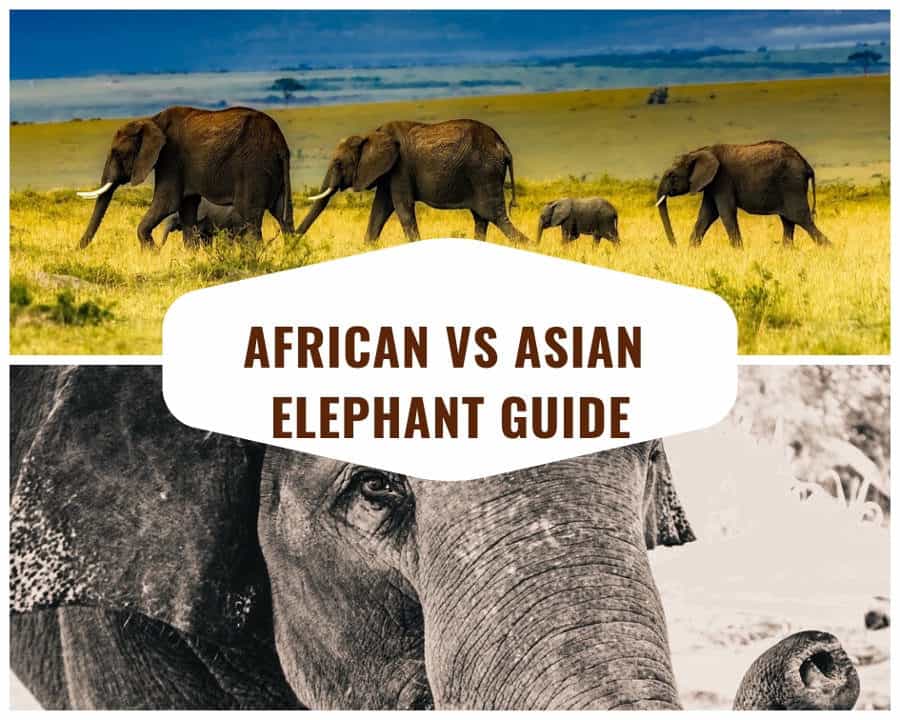
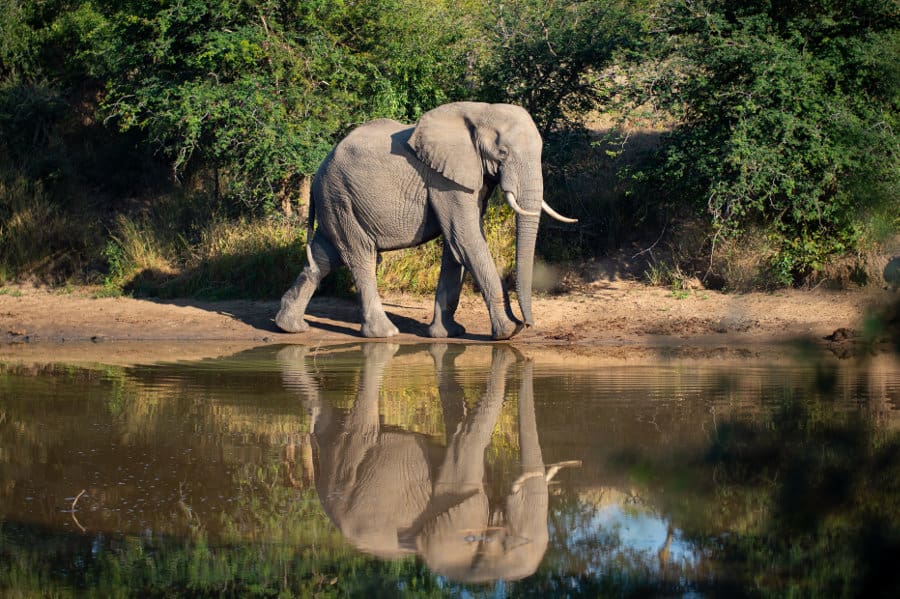
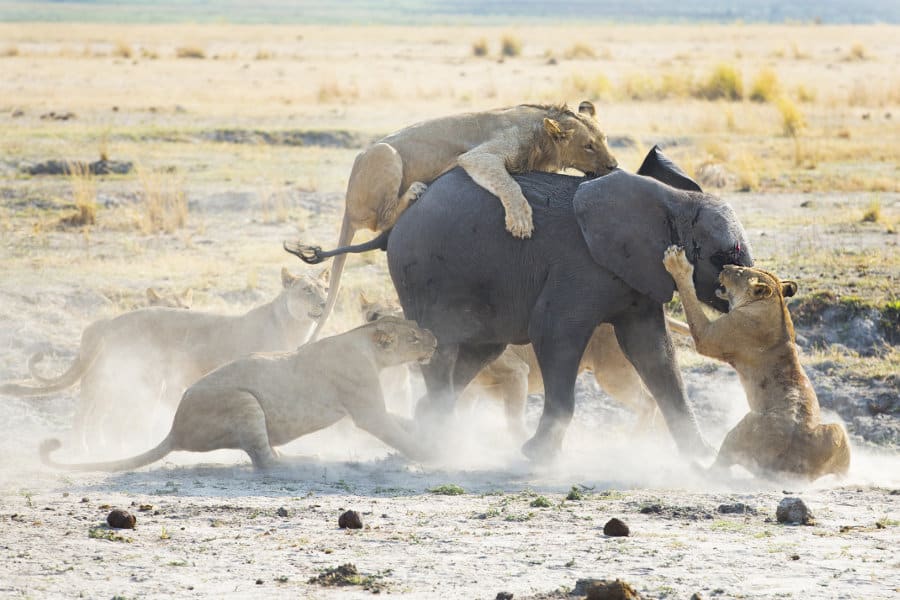
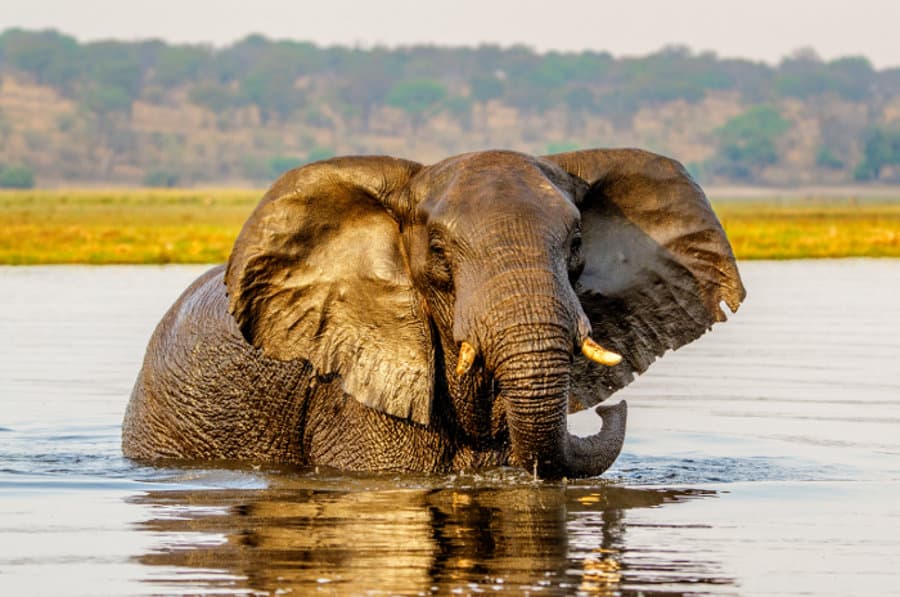
Comprehensive and quite helpful!
Was confused about something and would urge a rewrite of the bit about toes.
“ Now it starts getting complicated. Asian elephants have an extra toe, with five on the front feet and four on the back feet (compared with four and three). … They don’t really have toes, just two nails that are buried within the flesh of each foot.” Huh?!
That’s inherently contradictory!
Thanks for your comment, Ralph.
Even though they’re called elephant “toes”, they don’t really look as such (if you compare them to those of humans or other animals). Hence the somewhat contradictory statements.
Hope this helps! 😉